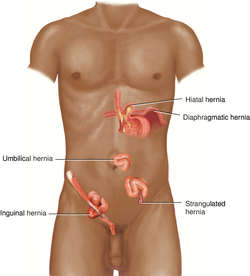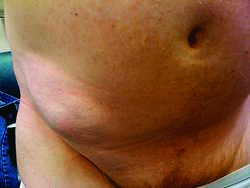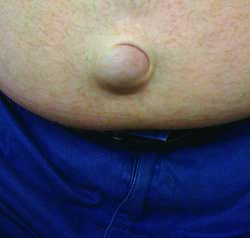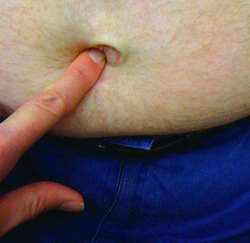hernia
(her'ne-a ) [L. hernia, rupture] 

COMMON LOCATIONS OF HERNIAS
The protrusion of an anatomical structure through the wall that normally contains it. Synonym: rupture (2) See:
illustration; herniotomy
hernialhernioid,
adjectiveEtiology
Hernias may be caused by congenital defects in the formation of body structures, defects in collagen synthesis and repair, trauma, or surgery. Conditions that increase intra-abdominal pressures, e.g., pregnancy, obesity, weight lifting, straining (the Valsalva maneuver), and abdominal tumors, may also contribute to hernia formation.
Treatment
Surgical or mechanical reduction is the treatment of choice.


ABDOMINAL WALL HERNIA
abdominal hernia
A hernia through the abdominal wall.
See: illustrationacquired hernia
A hernia that develops any time after birth in contrast to one that is present at birth (congenital hernia).
bladder hernia
The protrusion of the bladder or part of the bladder through a normal or abnormal orifice. Synonym: cystic hernia
Cloquet hernia
See: Cloquet, Jules G. complete hernia
A hernia in which the sac and its contents have passed through the aperture.
concealed hernia
A hernia that is not easily palpated.
congenital hernia
A hernia existing from birth.
crural hernia
A hernia that protrudes behind the femoral sheath.
Synonym: femoral hernia.cystic hernia
Bladder hernia.diaphragmatic hernia
Herniation of abdominal contents into the thoracic cavity through an opening in the diaphragm. The condition may be congenital, acquired (traumatic), or esophageal.
direct inguinal hernia
Inguinal hernia.diverticular hernia
The protrusion of an intestinal congenital diverticulum.
encysted hernia
A scrotal protrusion that, enveloped in its own sac, passes into the tunica vaginalis.
epigastric hernia
A hernia through a defect in the linea alba above the umbilicus.
fascial hernia
Protrusion of muscular tissue through its fascial covering.
fatty hernia
The prolapse of fat from its normal, anatomical position, e.g., from behind the peritoneum into the inguinal canal.
femoral hernia
Crural hernia.hiatal hernia
The protrusion of the stomach into the chest through the esophageal hiatus of the diaphragm.
; incarcerated hernia
A hernia in which the presenting content cannot be returned to its site of origin, e.g., a hernia in which a segment of intestine cannot be returned to the abdominal cavity. It may produce pain or intestinal obstruction. If left untreated, an incarcerated hernia may cause strangulation of the bowel.
incisional hernia
A hernia through a surgical scar.
incomplete hernia
A hernia that has not gone completely through the aperture.
indirect inguinal hernia
Inguinal hernia.inguinal hernia
The protrusion of a hernial sac containing intraperitoneal contents (e.g., intestine, omentum, or ovary) at the superficial inguinal ring. In an indirect inguinal hernia, the sac protrudes lateral to the inferior epigastric artery through the internal inguinal ring into the inguinal canal, often descending into the scrotum (in males) or labia (in females). In a direct inguinal hernia, the sac protrudes through the abdominal wall within Hesselbach's triangle, a region bounded by the rectus abdominis muscle, inguinal ligament, and inferior epigastric vessels. The sliding hernia is a kind of indirect inguinal hernia, in which a portion of the wall of the protruding cecum or sigmoid colon is part of the sac, the rest composed of parietal peritoneum. Femoral hernias occur where the femoral artery passes into the femoral canal. Indirect and direct inguinal hernias and femoral hernias are collectively referred to as groin hernias. Inguinal hernias account for about 80% of all hernias. Synonym:
direct inguinal hernia;
indirect inguinal hernia ;
hernia inguinalis;
lateral hernia;
medial hernia;
oblique herniaPatient care
Preoperative: The surgical procedure and expected postoperative course are explained to the patient. The patient should understand that the surgery will repair the defect caused by the hernia but that surgical failures can occur. If the patient is undergoing elective surgery, recovery usually is rapid; if no complications occur, the patient probably will return home the same day as surgery and usually can resume normal activity within 4 to 6 weeks. Patients who undergo emergency surgery for a strangulated or incarcerated hernia may remain hospitalized longer commensurate with the degree of intestinal involvement. The patient is prepared for surgery.
Postoperative: Vital signs are monitored. The patient is instructed on the changing of position to avoid undue stress on the wound area. Stool softeners may be administered to prevent straining during defecation, and the patient is instructed in their use. Early ambulation is encouraged, but other physical activities are modified according to the surgeon's instructions. The patient should void prior to discharge and be able to tolerate oral fluids. The patient is taught to check the incision and dressing for drainage, inflammation, and swelling and to monitor his/her temperature for fever, any of which should be reported to the surgeon. Analgesics are administered as prescribed, and the patient is taught about their use and supplied with a prescription for home use. Male patients are advised that scrotal swelling can be reduced by supporting the scrotum on a rolled towel and applying an ice bag. The patient is warned to avoid lifting heavy objects or straining during bowel movements. Drinking plenty of fluids should help the patient prevent constipation and maintain hydration. The patient is advised to make and keep a postoperative surgical visit and to resume normal activity and return to work only as permitted by the surgeon.
hernia inguinalis
Inguinal hernia.inguinocrural hernia
A hernia that is both femoral and inguinal.
internal hernia
A hernia that occurs within the abdominal cavity. It may be intraperitoneal or retroperitoneal.
interstitial hernia
A form of inguinal hernia in which the hernial sac lies between the layers of the abdominal muscles.
irreducible hernia
A hernia that cannot be returned to its original position out of its sac by manual methods.
See: incarcerated hernialabial hernia
The protrusion of a loop of bowel or other intraperitoneal organ into the labia majora.
lateral hernia
Inguinal hernia.lumbar hernia
A hernia through the inferior lumbar triangle (Petit) or the superior lumbar triangle (Grynfelt). It occurs most often in association with surgery on the kidneys or ureters.
medial hernia
Inguinal hernia.mesocolic hernia
A hernia between the layers of the mesocolon.
Nuckian hernia
A hernia into the canal of Nuck.
oblique hernia
Inguinal hernia.obturator hernia
A hernia through the obturator foramen.
omental hernia
A hernia containing a portion of the omentum.
ovarian hernia
The presence of an ovary in a hernial sac.
parastomal hernia
A hernia in the abdominal wall adjacent to a constructed stoma, e.g., a colostomy or iliostomy.
perineal hernia
Perineocele.phrenic hernia
A hernia projecting through the diaphragm into one of the pleural cavities.
posterior vaginal hernia
A hernia of Douglas' sac downward between the rectum and posterior vaginal wall. Synonym: enterocele (2)
properitoneal hernia
A hernia located between the parietal peritoneum and the transversalis fascia.


REDUCIBLE HERNIA: Umbilical Hernia


REDUCIBLE HERNIA: Hernia reduces with digital pressure
reducible hernia
A hernia whose contents can be replaced by manipulation.
See: illustrationretroperitoneal hernia
A hernia protruding into the retroperitoneal space, e.g., duodenojejunal hernia, Treitz's hernia.
Richter's hernia
A hernia in which only a portion of intestinal wall protrudes, the main portion of the intestine being excluded from the hernial sac and the lumen remaining open. The patient may present with groin swelling and vague abdominal complaints; when incarcerated the hernia may produce bowel ischemia and related complications.
scrotal hernia
A hernia that descends into the scrotum.
sliding hernia
A hernia in which a portion of the wall of the herniated structure forms part of the hernia sac, e.g. an inguinal hernia in which a wall of the cecum or sigmoid colon forms a portion of the sac, the remainder of the sac being parietal peritoneum.
Spigelian hernia
A defect that occurs at or below the linea semicircularis but above the point at which the inferior epigastric vessels cross the lateral border of the rectus abdominis muscle. This type of hernia may contain preperitoneal fat or may be a peritoneal sac containing intraperitoneal contents. It is rare and difficult to diagnose unless large, because it is typically not palpable when small. Large Spigelian hernias may be mistaken for sarcomas of the abdominal wall. Ultrasonography or computed tomography scans are often used in diagnosis.
Treatment
Small Spigelian hernias are easily repaired; larger ones may require a prosthesis.
sports hernia
Athletic pubalgia.strangulated hernia
A hernia in which the protruding viscus is so tightly trapped that gangrene results, requiring prompt surgery. Once strangulation of the contents occurs, a nonsurgical attempt to reduce it may severely compromise treatment and outcome.
synovial hernia
Protrusion of a portion of synovial membrane through a tear in the stratum fibrosum of a joint capsule.
umbilical hernia
A hernia occurring at the navel, seen mostly in children. Usually it requires no therapy if small and asymptomatic. An umbilical hernia usually resolves when the child begins to walk (and muscles strengthen).
uterine hernia
The presence of the uterus in the hernial sac.
vaginal hernia
Pelvic organ prolapse.vaginolabial hernia
A hernia of a viscus into the posterior end of the labia majora.
ventral hernia
A hernia through the abdominal wall. See: incisional hernia
Medical Dictionary, © 2009 Farlex and Partners



